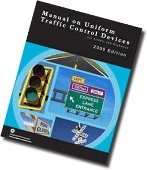Article from: www.thenewspaper.com/news/39/3953.asp
11/19/2012
Group Challenges Feds to Improve Intersection Safety
National Motorists Association challenges US Transportation Department to update signal timing regulations.
 Cities around the country that have experimented with longer yellow signal times have reported great success in improving safety. Georgia towns, for example, saw 80 percent reductions in violations after a law kicked in mandating longer yellows (view results). Last month, the Transportation Research Board of the National Academies came out with a recommendation that would result in adding an extra 0.5 seconds of yellow to the average signal (view report).
Cities around the country that have experimented with longer yellow signal times have reported great success in improving safety. Georgia towns, for example, saw 80 percent reductions in violations after a law kicked in mandating longer yellows (view results). Last month, the Transportation Research Board of the National Academies came out with a recommendation that would result in adding an extra 0.5 seconds of yellow to the average signal (view report).
In light of the growing consensus, National Motorists Association (NMA) is leaning on transportation officials in Washington in the hope that they will update national regulations. In a letter sent Thursday, the Wisconsin-based group asked Federal Highway Administration head Victor Mendez to update the Manual of Uniform Traffic Control Devices (MUTCD) so that local governments could no longer get away with just posting intersections at the current 3.0 second minimum.
"The MUTCD should establish a national requirement for a minimum yellow-light change interval, one that enhances intersection safety by replacing the current general guideline in 4D.26 that allows states to set short yellows that are unsafe to motorists, cyclists, and pedestrians," the letter stated.
Section 4D.26 simply states that yellow times must be between 3 and 6 seconds in duration. NMA President Gary Biller says this vague standard is making intersections more hazardous -- and in many cases, more profitable.
"The timing of yellow lights at signalized intersections is one of the most important design parameters for lowering intersection violation and accident rates," Biller said in an emailed statement. "Yet amazingly there is no federal requirement for determining safety-based yellow intervals, just some optional guidance in the FHWA's Manual on Uniform Traffic Control that many red-light camera operators use to justify dangerously short yellows in order to maximize the profits of their programs."
NMA's letter singles out Chicago, Illinois which employs a blanket policy of 3.0 second yellows at high-speed intersections. With the country's largest network of red light cameras, the Windy City is able to generate $70 million from tickets issued primarily from motorists who misjudge the length of the yellow by a split second.
"The FHWA has an obligation, as the agency responsible for regulating traffic signals, to establish clear safety requirements that eliminate such predatory practices," Biller said. "The National Motorists Association is calling upon the FHWA to do exactly that and has recommended a specific engineering solution based upon work by the Institute of Transportation Engineers.”
A copy of the letter is available in a 300k PDF file at the source link below.
Source: Letter to FHWA Administrator Victor Mendez (National Motorists Association, 11/15/2012)
Permanent Link for this item
Return to Front Page
 Cities around the country that have experimented with longer yellow signal times have reported great success in improving safety. Georgia towns, for example, saw 80 percent reductions in violations after a law kicked in mandating longer yellows (view results). Last month, the Transportation Research Board of the National Academies came out with a recommendation that would result in adding an extra 0.5 seconds of yellow to the average signal (view report).
Cities around the country that have experimented with longer yellow signal times have reported great success in improving safety. Georgia towns, for example, saw 80 percent reductions in violations after a law kicked in mandating longer yellows (view results). Last month, the Transportation Research Board of the National Academies came out with a recommendation that would result in adding an extra 0.5 seconds of yellow to the average signal (view report).